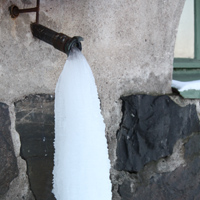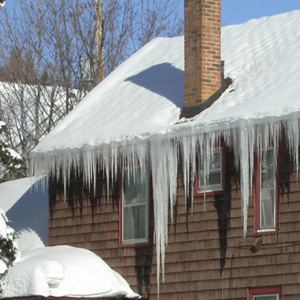 While stopping a leak, or repairing a hose down in your basement might be an easy job, there are forms of moisture penetration that happen during the winter, that involve much more hassle. Unless you are a frequent visitor to your attic during frigid winter months, this damage might even evade your notice.
While stopping a leak, or repairing a hose down in your basement might be an easy job, there are forms of moisture penetration that happen during the winter, that involve much more hassle. Unless you are a frequent visitor to your attic during frigid winter months, this damage might even evade your notice.
The first type of water damage issue caused by wintry weather is an ice dam. When the temperature in your attic is above freezing, the snow on your roof will melt. When this runs down the roof and hits the colder levels, it refreezes. If this cycle repeats over and over, the freezing snow builds up and forms a dam of ice. This causes water to pond, and this ponding water then backs up under the roof covering and leaks into the attic or along exterior walls. The right weather conditions already exist during winter, which include temperatures in the 20’s for a few days, with several inches of snow on your roof.
Another common issue is attic condensation. Condensation of water vapor on cold surfaces in attics can cause wood to rot, which leads to extremely expensive structural repairs. Condensation typically occurs when warm, moist air migrates into your attic from the living spaces below. This is especially true if you have high humidity content in your living spaces.
Local building codes may have requirements that attempt to prevent the problem of ice dams and attic condensation. But codes don’t address all the issues, and many homes are built without following codes. The designer who designed your home has to know about the relationship between humidity and air movement, when they are designing and constructing homes, so issues like these don’t occur. You can also take several steps to prevent ice dams and condensation in your attic –
- Prevent warm air, coming from downstairs, from infiltrating your attic by appropriately insulating your attic’s floor and using a dehumidifier to control water vapor.
- You should seal all openings allowing water vapor into the attic.
- Heat your attic or install a small heater to keep your attic above freezing temperatures.
- Assure good attic ventilation, replacing warm air with cold air from outside.
Its tempting to just climb up and attempt to break up that ice dam. We don’t recommend this, because its dangerous on your roof during this time of year, and you can cause large amounts of damage to your roof in the pursuit of breaking up that annoyance. This means you shouldn’t do things like routinely remove snow from the roof or attempt to “chip away” the ice of an ice dam – as this will damage your shingles. You shouldn’t install large mechanical equipment, or water heaters in your attic, especially if it snows where you live. Not only does this present a fire hazard, but it increase the temperature in your attic. Also, never use salt or calcium chloride to melt snow on your roof, because these chemicals are corrosive and will destroy your metal gutters, downspouts, and flashings. Runoff water containing these chemicals damage nearby grass and plants.
amounts of damage to your roof in the pursuit of breaking up that annoyance. This means you shouldn’t do things like routinely remove snow from the roof or attempt to “chip away” the ice of an ice dam – as this will damage your shingles. You shouldn’t install large mechanical equipment, or water heaters in your attic, especially if it snows where you live. Not only does this present a fire hazard, but it increase the temperature in your attic. Also, never use salt or calcium chloride to melt snow on your roof, because these chemicals are corrosive and will destroy your metal gutters, downspouts, and flashings. Runoff water containing these chemicals damage nearby grass and plants.
Following these simple do’s and don’ts will help exponentially in the fight against winter-month water penetration. If you find your home is water damaged, call the local experts at DryPatrol!
